Modelling and Forecast of Future Growth for Shandong’s Small Industrial Towns: A Scenario-Based Interactive Approach
Abstract
1. Introduction
2. Town Growth Modeling Approach
2.1. History of the Development of Town Growth Models
2.2. Types of Classical Town Growth Models
3. Analysis of the Characteristics of Small Towns in Shandong and Selection of Applicable Models
3.1. Typical Characteristics of Small Towns in Shandong
- (1)
- Characteristics of the construction model of the dual organization
- (2)
- Specialized industrial structure features
3.2. Prerequisites for Constructing a Model of Small-Town Growth in Shandong
- (1)
- Organizational model
- (2)
- Limited budget
- (3)
- Planning practice
4. Constructing a Growth Model Applicable to Small Towns in Shandong
4.1. Model Framework Construction
4.2. Small Town Growth Impact Factor Selection
- Geographic elements: slope and distance from bodies of water.
- Ecological elements: forests and wetlands.
- Demographic elements: population density.
- Economic factors: existing towns, distance from central business districts, distance from central industrial districts, distance from existing towns.
- Policy elements: conservation lands and urban agglomeration gravity.
- Cultural elements: historical and cultural conservation areas.
- Infrastructural elements: distance to roads, distance to major roads, distance to major nodes, road density, and distance to shorelines (river banks).
4.3. Classification of Small-Town Growth Patterns
4.4. Growth Interaction Model Framework
5. Statistical Forecast of Small-Town Growth
5.1. Status of the Case
5.2. Logistic Regression Results
5.3. Analysis of Statistical Results
- Persistent insignificance: road density
- Progressively significant: distance from water bodies, urban agglomeration gravity, and distance from main roads
- Progressively insignificant: slope, built-up area
- Other: population density, forest (not significant 1979–2009)
5.4. Town Growth Forecast
6. System Dynamic Model Forecast
7. Conclusions
Author Contributions
Funding
Institutional Review Board Statement
Informed Consent Statement
Data Availability Statement
Conflicts of Interest
References
- Fu, Y.; Zhang, Q. A Research on Community Boundary Space of Small Towns. J. Hum. Settl. West China 2014, 29, 74–79. [Google Scholar] [CrossRef]
- Chen, Q.; Pan, B.; Si, M. Influence of Urban-Rural Integration on Regional Specialization Division of Small Towns: A Case Study of Zhejiang Province. City Plan. Rev. 2019, 43, 22–28. [Google Scholar]
- Qi, L. On the Predicament and Outlet of Town Planning—Also on the implementation Suggestions of Town Planning Standard. Dev. Small Cities Towns 2015, 37–40. [Google Scholar]
- Yun, Y.; Yan, L. A Tentative Study on the Strategy of Cross-regional Industry Development in Small Cities and Towns Located in Urban Fringe: Taking Three Towns in the Southern Feicheng of Shandong Province as Examples. Dev. Small Cities Towns 2017, 4, 32–37, 50. [Google Scholar]
- Li, X.; Yin, Q.; Zhang, J. The path, model and policy of urbanization in China. Urban Plan. Forum 2014, 2, 3. [Google Scholar]
- Guan, C.; Rowe, P.G. The concept of urban intensity and China’s townization policy: Cases from Zhejiang Province. Cities 2016, 55, 22–41. [Google Scholar] [CrossRef]
- Song, D.; Yao, C. Forty Years of Reform and Opening up:The Roads Choice for China’s Urbanization and Urban Agglomerations. J. Liaoning Univ. (Philos. Soc. Sci.) 2018, 46, 45–52. [Google Scholar] [CrossRef]
- Zhang, L.; Bai, Y.; Pang, L. The Research Progress and Prospect of Small Town Development and Planning in China since 2000. Urban Rural. Plan. 2022, 1, 61–85. [Google Scholar]
- Liu, M. Study on operation mechanism of urban planning Management under market economy. Wind. Sci. Technol. 2018, 11, 182. [Google Scholar] [CrossRef]
- Zhu, J. The Impact of Renewal During Land Rent on the Formation of Urban Structure and Urban Institutional Change. J. Geogr. 2016, 2, 28–34. [Google Scholar] [CrossRef]
- Yang, L.; Zhang, Z.; Chen, C. Simulation of small and medium-sized urban land expansion based on multi-agent system model. Intell. City 2021, 7, 11–13. [Google Scholar] [CrossRef]
- Fu, Y.; Liu, Y. Study on the characteristics and influencing factors of construction land expansion in small towns. Constr. Stand. 2022, 9, 68–70. [Google Scholar]
- Mu, F.; Li, Q.; Ma, Y. Change and Driving Factors of Urban Construction Land in Chongqing Based on Geodetector. J. Chongoing Jiaotong Univ. (Nat. Sci.) 2021, 40, 74–81, 87. [Google Scholar]
- Wang, H.; Xia, C.; Zhang, A. Space syntax expand intensity index and its applications to quantitative analysis of urban expansion. J. Geogr. 2016, 71, 1302–1314. [Google Scholar]
- Feng, Y.; Zhao, Y.; Xue, C. Suitability evaluation of spatial expansion of urban construction land in Karst mountainous areas-Take Ziyun county as an example. J. Guizhou Norm. Univ. (Nat. Sci. Ed.) 2019, 37, 1–8, 65. [Google Scholar] [CrossRef]
- Ding, Z.; Liu, Y.; Wu, X. Spatial Differentiation Pattern and Its Influencing Factors of Town Economy in China:Based on 31 755 Towns’ per Capita Net Income of Farmers. Econ. Geogr. 2020, 40, 18–28, 38. [Google Scholar] [CrossRef]
- Qiao, L.; Li, J. Research on Energy consumption estimation method based on land use classification in small towns. Urban Plan. 2011, 2, 56–61. [Google Scholar]
- Ning, S.; Li, L.; Wang, W. Research on the Evaluation of Vibrancy of Characteristic Towns from Perspective of Big Data on Tourist Amount: Taking Nine Characteristic Towns in the Eastern Part of China as an Example. Urban Plan. 2018, 36, 43–48. [Google Scholar]
- Gong, H.; Yang, L.; Qiao, J. Research from the on the Spatial Evolution and Development Boundary Delimitation of Small Towns Perspective of ‘New Economic Flow’. Dev. Small Citys Towns 2022, 40, 5–15. [Google Scholar]
- Wu, C.; Wang, Z. Study on Ecological Planning and Design of small towns. Urban Resid. 2021, 28, 170–171. [Google Scholar]
- Wang, Y.; Yang, T. Application of space syntax in the implementation evaluation of urban planning: A case study of the city master plan of YuXi, YunNan Povince. City Plan. Rev. 2018, 42, 71–78. [Google Scholar]
- Foot, D. Operational Urban Models: An Introduction; Routledge: London, UK, 2017; pp. 15–20. [Google Scholar]
- Díez Medina, C. Die Stadt im 20. Jahrhundert. Visionen, Entwürfe, Gebautes; Verlag Klaus Wagenbach GmbH: Berlin, Germany, 2013; pp. 26–30. [Google Scholar]
- Bettencourt, L.; West, G. A unified theory of urban living. Nature 2010, 467, 912–913. [Google Scholar] [CrossRef] [PubMed]
- Zhang, Y.; Meng, B.; Zhu, H. Review of Urban Growth Simulation Model. J. Beijing Union Univ. 2014, 28, 6–12. [Google Scholar] [CrossRef]
- Ismagilova, E.; Hughes, L.; Rana, N.P.; Dwivedi, Y.K. Security, privacy and risks within smart cities: Literature review and development of a smart city interaction framework. Inf. Syst. Front. 2022, 24, 393–414. [Google Scholar] [CrossRef] [PubMed]
- He, S.; Fang, B.; Li, X. Spatiotemporal Pattern Evolution and Interactive Response of Urban Land Use Efficiency and High-Quality Development Level: A Case Study of Jiangsu Province. Geogr. Geo Inf. Sci. 2022, 5, 79–87. [Google Scholar]
- Sonsin, A.; Cortes, M.; Nunes, D.; Gomes, J.; Costa, R. Computational analysis of 3D Ising model using metropolis algorithms. J. Phys. Conf. Ser. 2015, 630, 012057. [Google Scholar] [CrossRef]
- Gao, X.; Cai, J. Optimization analysis of urban function regional planning based on big data and GIS technology. Bol. Tec. /Tech. Bull. 2017, 55, 344–351. [Google Scholar]
- Kaiser, K.E.; Flores, A.; Vernon, C.R. Janus: A Python package for agent-based modeling of land use and land cover change. J. Open Res. Softw. 2020, 8, 15. [Google Scholar] [CrossRef]
- Alonso, A.; Monzón, A.; Wang, Y. Modelling land use and transport policies to measure their contribution to urban challenges: The case of Madrid. Sustainability 2017, 9, 378. [Google Scholar] [CrossRef]
- Royle, J.A.; Fuller, A.K.; Sutherland, C. Unifying population and landscape ecology with spatial capture–recapture. Ecography 2018, 41, 444–456. [Google Scholar] [CrossRef]
- Alonso, W. Location and Land Use; Harvard University Press: Cambridge, MA, USA, 2013; pp. 35–40. [Google Scholar]
- Hensher, D.A.; Johnson, L.W. Applied Discrete-Choice Modelling; Routledge: London, UK, 2018; pp. 20–25. [Google Scholar]
- Schirmer, P.M.; Van Eggermond, M.A.; Axhausen, K.W. The role of location in residential location choice models: A review of literature. J. Transp. Land Use 2014, 7, 3–21. [Google Scholar] [CrossRef]
- Cervero, R. Linking urban transport and land use in developing countries. J. Transp. Land Use 2013, 6, 7–24. [Google Scholar] [CrossRef]
- Piroozfar, P.A.; Piller, F.T. Mass Customisation and Personalisation in Architecture and Construction; Routledge New York: New York, NY, USA, 2013; pp. 18–23. [Google Scholar]
- Evans, T.P.; Kelley, H. Multi-scale analysis of a household level agent-based model of landcover change. J. Environ. Manag. 2004, 72, 57–72. [Google Scholar] [CrossRef] [PubMed]
- Conte, R.; Hegselmann, R.; Terna, P. Simulating Social Phenomena; Springer Science & Business Media: Berlin, Germany, 2013; Volume 456, pp. 15–26. [Google Scholar]
- Lee, D.B., Jr. Requiem for large-scale models. J. Am. Inst. Plan. 1973, 39, 163–178. [Google Scholar] [CrossRef]
- Schmitt, G. A planning environment for the design of future cities. In Digital Urban Modeling and Simulation; Springer: Berlin, Heidelberg, Germany, 2012; pp. 3–16. [Google Scholar]
- McFadden, D. Modelling the choice of residential location. In Spatial Interaction Theory and Planning Models; Elsevier (North Holland Publishing Co.): Amsterdam, The Netherlands, 1978; pp. 75–96. [Google Scholar]
- Putman, S. Integrated Urban Models Volume 1: Policy Analysis of Transportation and Land Use (RLE: The City); Routledge: London, UK, 2013; pp. 55–57. [Google Scholar]
- Carr, M.H.; Zwick, P.D. Smart Land-Use Analysis: The LUCIS Model Land-Use Conflict Identification Strategy; ESRI, Inc.: Redlands, CA, USA, 2007; pp. 26–35. [Google Scholar]
- Cao, S.; Ding, S.; Sun, F. Research on the Impact of New Urbanization Comprehensive Pilot Policy on Urban Development Quality. J. Huazhong Agric. Univ. (Soc. Sci. Ed.) 2021, 5, 75–84, 194–195. [Google Scholar] [CrossRef]
- Li, X.; Li, L.; Zhou, R. Planning and characteristic construction of tourism small towns in minority areas. Dev. Small Cities Towns 2012, 10, 71–74. [Google Scholar]
- Cai, Q. Study on the Method of Building Geochemical Evaluation Database of Land Quality-Taking Diaozhen Town and Xinzhai Town of Ghangqiu City as Examples. Shandong Land Land Quali Rcsourccs 2020, 36, 67–71. [Google Scholar]
- Gu, C. Study on urban agglomeration:Progress and prospects. Geogr. Res. 2011, 30, 771–784. [Google Scholar]
- Yang, Y.; Zhou, Z.; Wang, X. A Preliminary Study on the Construction Method of Small town Planning Analysis. J. Hum. Settl. West China 2022, 37, 94–101. [Google Scholar] [CrossRef]
- Li, D.; Liu, C.; Zhao, J. Research on application analysis of GIS technology in spatial organization. J. Shandong Jianzhu Univ. 2020, 35, 48–53. [Google Scholar]
- Li, D.; Liu, C.; Zhao, J. Research progress of application of GIS in spatial organization of industrial parks. J. Shandong Jianzhu Univ. 2019, 34, 64–69. [Google Scholar]
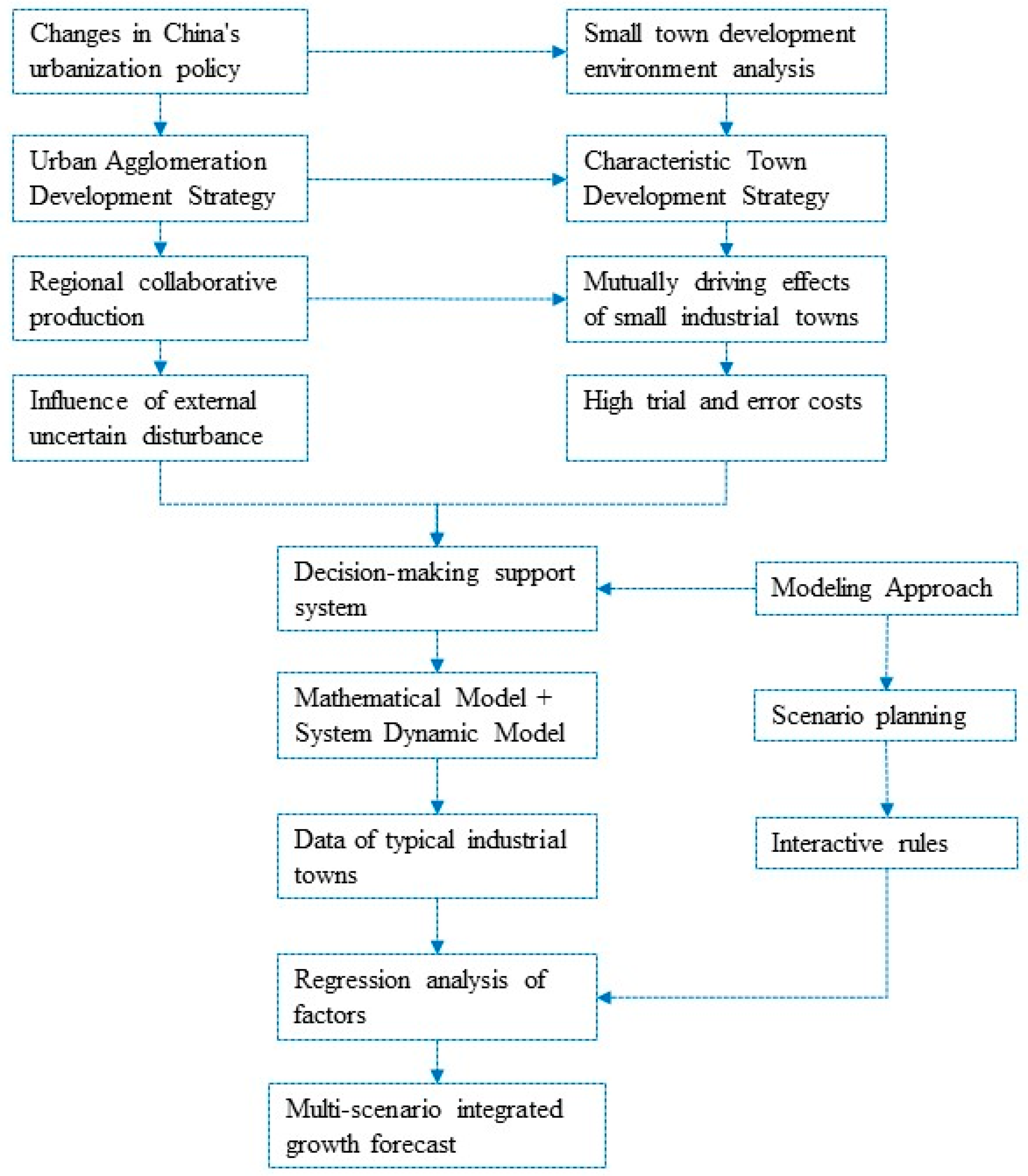
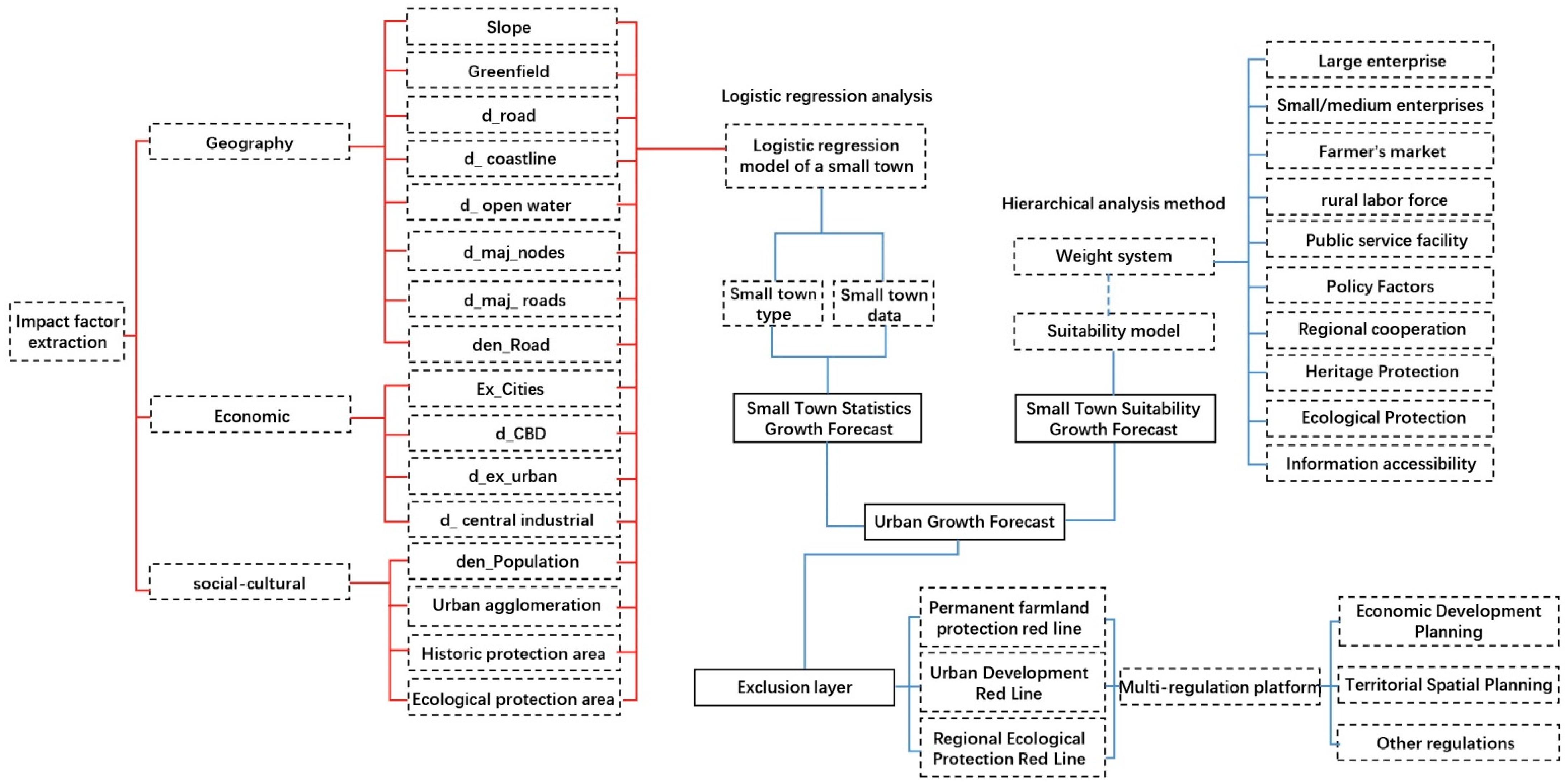
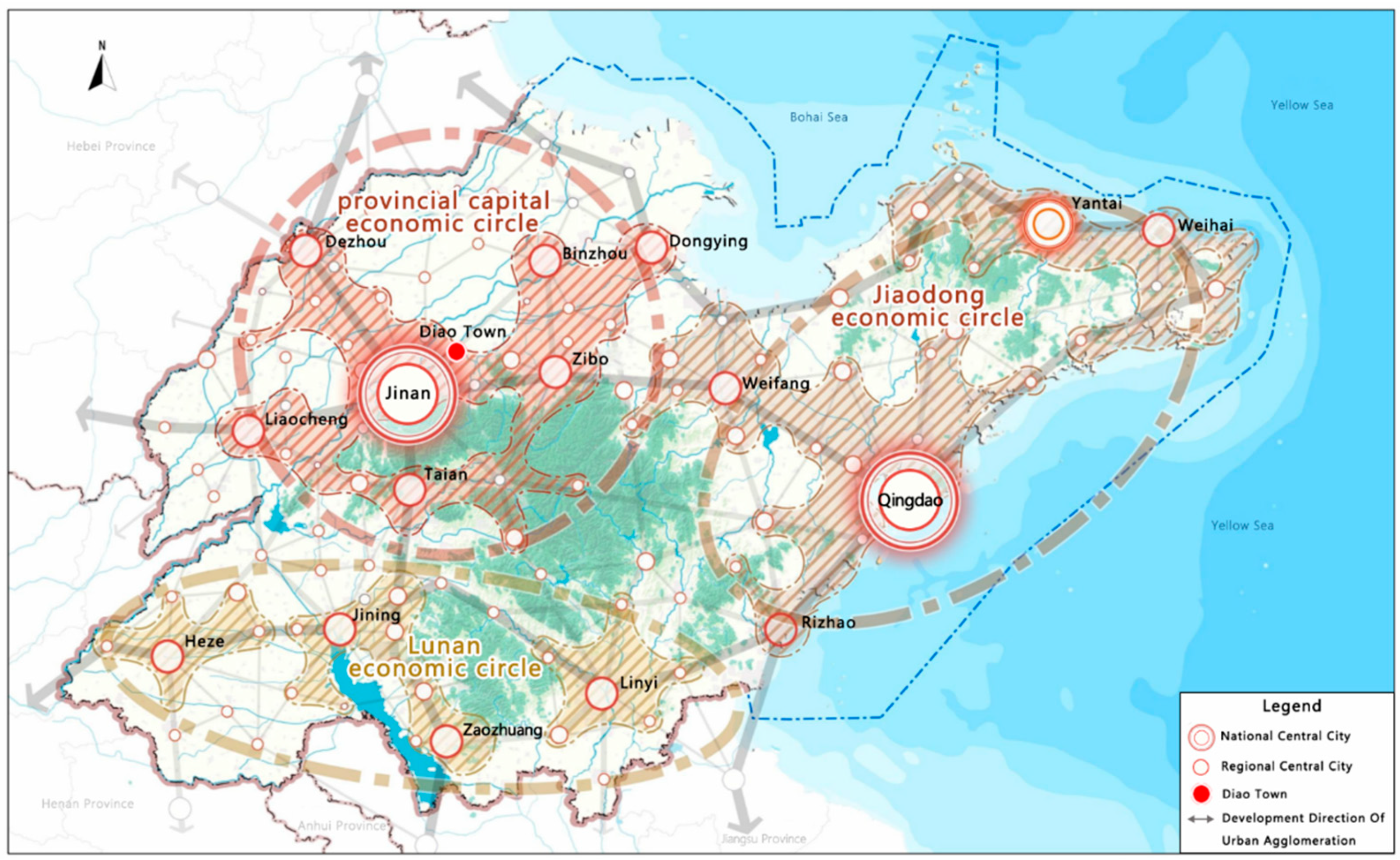
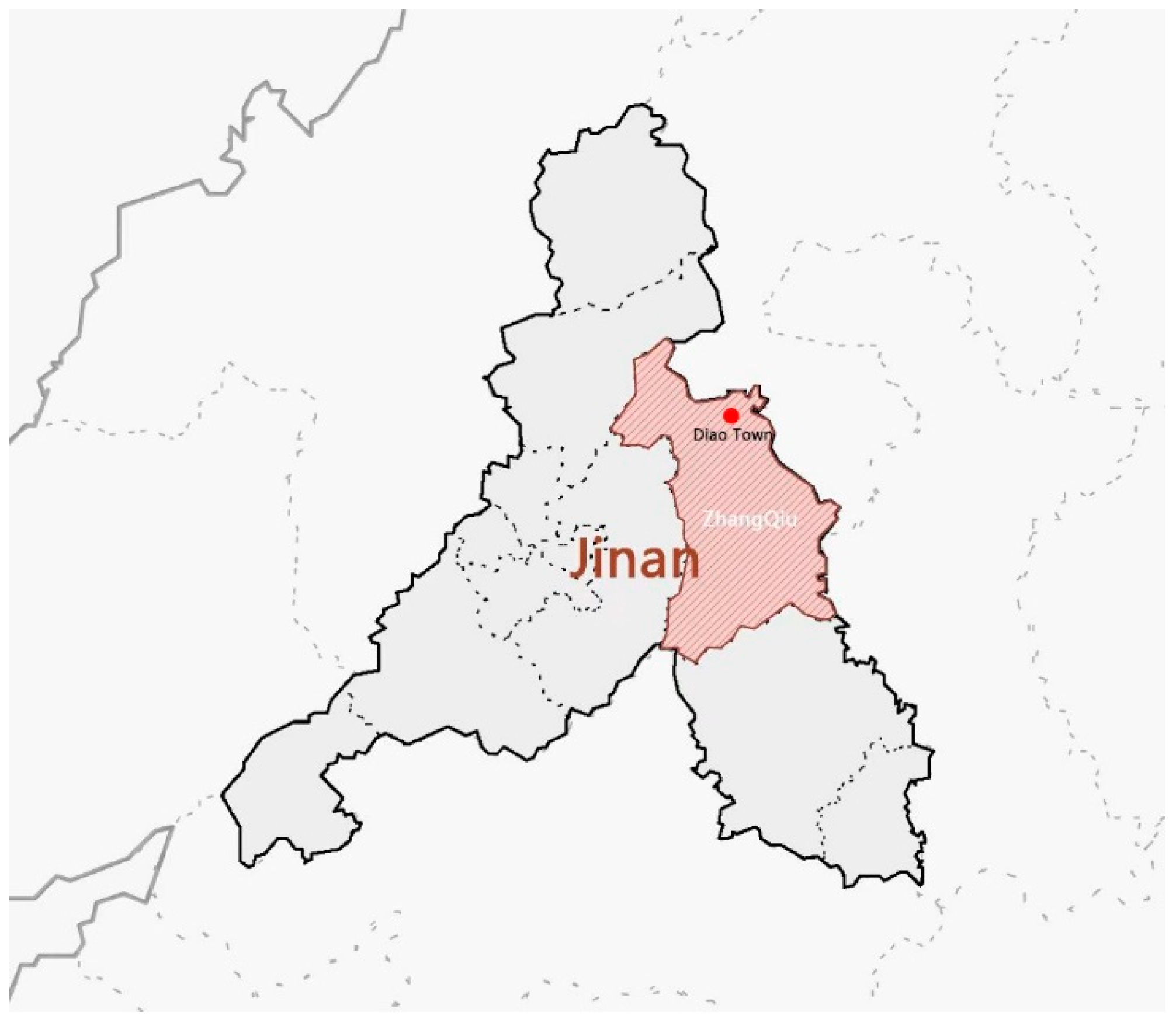
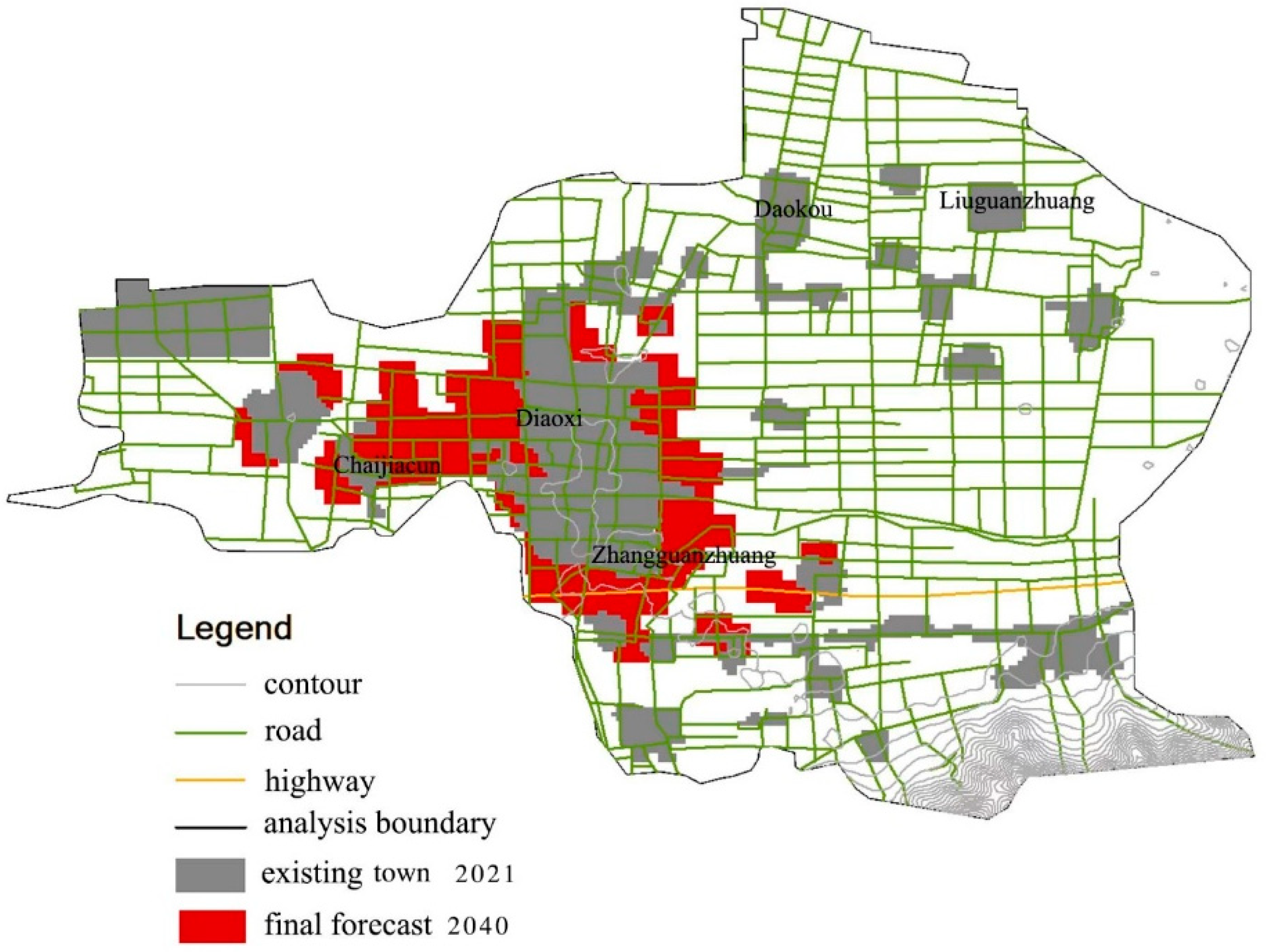

| Model Name | Methodology | Organizational Model | Application Limitations |
|---|---|---|---|
| Spatial autocorrelation model | Gravitational theory | Other-Organization | Low accuracy and lack of planning theory support |
| Mathematical model | Economics/statistical theory | Self-Organization | Representing full benefits through economic gains, ignoring trial and error costs |
| Cellular automaton | Bionics method | Self-Organization | Rules are too complex for a government-led system |
| Agent-based models | Theories related to Artificial Intelligence | Self-Organization | Rules are too complex and costly to construct for a government-led system |
| Variable Name | B | Std. Error | Wald | Df | Sig | Exp (B) |
|---|---|---|---|---|---|---|
| Distance to open water | 0.000 | 0.000 | 2.377 | 1 | 0.123 | 1.000 |
| Distance to industry | 0.000 | 0.000 | 4.572 | 1 | 0.032 | 1.000 |
| Distance to town | −0.006 | 0.000 | 242.981 | 1 | 0.000 | 0.994 |
| Distance to highway | 0.000 | 0.000 | 22.459 | 1 | 0.000 | 1.000 |
| Distance to major roads | 0.000 | 0.000 | 1.775 | 1 | 0.183 | 1.000 |
| Road density | 43.395 | 28.675 | 2.290 | 1 | 0.130 | 7.017 × 1018 |
| Town agglomeration gravitation | 0.000 | 0.000 | 0.010 | 1 | 0.920 | 1.000 |
| Slop | 0.133 | 0.030 | 19.095 | 1 | 0.000 | 1.142 |
| Population density | 0.001 | 0.000 | 31.482 | 1 | 0.000 | 1.001 |
| Distance to node | 0.000 | 0.000 | 13.241 | 1 | 0.000 | 1.000 |
| Existing town | −4.172 | 0.190 | 480.107 | 1 | 0.000 | 0.015 |
| Protected land | −7.418 | 0.444 | 279.676 | 1 | 0.000 | 0.001 |
| CONSTANT | 1.644 | 0.550 | 8.944 | 1 | 0.003 | 5.177 |
| Variable Name | B | Std. Error | Wald | Df | Sig | Exp (B) |
|---|---|---|---|---|---|---|
| Distance to open water | −0.001 | 0.000 | 129.388 | 1 | 0.000 | 0.999 |
| Distance to industry | 0.002 | 0.000 | 356.500 | 1 | 0.000 | 1.002 |
| Distance to highway | 0.001 | 0.000 | 268.541 | 1 | 0.000 | 1.002 |
| Distance to major roads | −0.001 | 0.000 | 192.713 | 1 | 0.000 | 0.999 |
| Road density | 15.959 | 24.513 | 0.424 | 1 | 0.515 | 8,533,084.803 |
| Town agglomeration gravitation | −0.002 | 0.000 | 271.095 | 1 | 0.000 | 0.998 |
| Slop | 0.053 | 0.037 | 2.063 | 1 | 0.151 | 1.054 |
| Population density | 0.000 | 0.000 | 24.599 | 1 | 0.000 | 1.000 |
| Distance to node | 0.000 | 0.000 | 19.744 | 1 | 0.000 | 1.000 |
| Protected land | −7.774 | 0.374 | 430.964 | 1 | 0.000 | 0.000 |
| Distance to town | −0.003 | 0.000 | 145.033 | 1 | 0.000 | 0.997 |
| Existing town | −21.383 | 783.849 | 0.001 | 1 | 0.978 | 0.000 |
| CONSTANT | 15.981 | 783.849 | 0.000 | 1 | 0.984 | 8,721,073.526 |
| Variable Name | B | Std. Error | Wald | Df | Sig | Exp (B) |
|---|---|---|---|---|---|---|
| Distance to open water | 0.000 | 0.000 | 4.442 | 1 | 0.035 | 1.000 |
| Distance to industry | 0.001 | 0.000 | 61.261 | 1 | 0.000 | 1.001 |
| Distance to highway | 0.001 | 0.000 | 30.630 | 1 | 0.000 | 1.001 |
| Distance to major roads | −0.001 | 0.000 | 98.618 | 1 | 0.000 | 0.999 |
| Road density | −34.820 | 37.908 | 0.844 | 1 | 0.358 | 0.000 |
| Town agglomeration gravitation | −0.002 | 0.000 | 64.408 | 1 | 0.000 | 0.998 |
| Slop | −0.145 | 0.066 | 4.875 | 1 | 0.027 | 0.865 |
| Population density | 0.000 | 0.000 | 0.525 | 1 | 0.469 | 1.000 |
| Distance to node | 0.001 | 0.000 | 49.181 | 1 | 0.000 | 1.001 |
| Protected land | −18.770 | 210.448 | 0.008 | 1 | 0.929 | 0.000 |
| Distance to town | −0.011 | 0.001 | 167.241 | 1 | 0.000 | 0.989 |
| Existing town | −33.987 | 523.461 | 0.004 | 1 | 0.948 | 0.000 |
| CONSTANT | 29.439 | 523.461 | 0.003 | 1 | 0.955 | 6,095,597,479,066.454 |
Publisher’s Note: MDPI stays neutral with regard to jurisdictional claims in published maps and institutional affiliations. |
© 2022 by the authors. Licensee MDPI, Basel, Switzerland. This article is an open access article distributed under the terms and conditions of the Creative Commons Attribution (CC BY) license (https://creativecommons.org/licenses/by/4.0/).
Share and Cite
Yang, Y.; Liu, C.; Li, B.; Zhao, J. Modelling and Forecast of Future Growth for Shandong’s Small Industrial Towns: A Scenario-Based Interactive Approach. Sustainability 2022, 14, 16823. https://doi.org/10.3390/su142416823
Yang Y, Liu C, Li B, Zhao J. Modelling and Forecast of Future Growth for Shandong’s Small Industrial Towns: A Scenario-Based Interactive Approach. Sustainability. 2022; 14(24):16823. https://doi.org/10.3390/su142416823
Chicago/Turabian StyleYang, Yang, Chunlu Liu, Baizhen Li, and Jilong Zhao. 2022. "Modelling and Forecast of Future Growth for Shandong’s Small Industrial Towns: A Scenario-Based Interactive Approach" Sustainability 14, no. 24: 16823. https://doi.org/10.3390/su142416823
APA StyleYang, Y., Liu, C., Li, B., & Zhao, J. (2022). Modelling and Forecast of Future Growth for Shandong’s Small Industrial Towns: A Scenario-Based Interactive Approach. Sustainability, 14(24), 16823. https://doi.org/10.3390/su142416823








